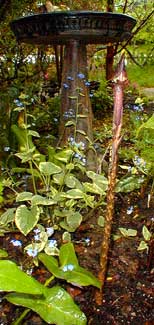
Himalayan Cobra Lily;
with notes on Vishnu & Lakshmi
"Whomsoever is a devotee of Vishnu
Has empathy for the whole world
Performing helpful deeds
Without expecation of reward.
A devotee of Vishnu
Embraces & praises the world."
-Narsimha Mehta
(1414-1480)
(1414-1480)
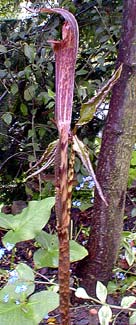 Jack-in-the-Pulpits or Cobra Lilies are among my favorite shade plants. They're among the most exotic of hardy temperate flowers.
Jack-in-the-Pulpits or Cobra Lilies are among my favorite shade plants. They're among the most exotic of hardy temperate flowers.Arisaema nepenthoides is the tallest of our several jack-in-the-pulpits. The slender spathe is upheld to nearly a yard high on a striped & speckled stem that has the quality of snakeskin.
In Nepal where Naga the Cobra is a sacred being, the Cobra Lily becomes by its resemblance likewise sacred to Lord Vishnu & to wealth-giving Lakshmi the energizing power of Lord Vishnu. Lakshme is frequently depicted in her placid two-armed aspect seated with Lord Vishnu beneath the seven-faced cobra's hood.
An example of such representation is shown on this page, a temple relief from Ellora, Maharashtra, showing Vishnu & Lakshmi beneath the multi-headed cobra.
 It is Vishnu's Cobra that banishes sorrow by reuniting the dead with Vishnu the Sustainer. Though in general Lakshmi is gentle, she does have a warlike eight-armed aspect baring many weapons & called Mahalakshmi, destroyer of the demons of poverty & failure.
It is Vishnu's Cobra that banishes sorrow by reuniting the dead with Vishnu the Sustainer. Though in general Lakshmi is gentle, she does have a warlike eight-armed aspect baring many weapons & called Mahalakshmi, destroyer of the demons of poverty & failure.The Cobra or Kala Nag of Vishnu is named Ananta the Endless, generally with seven heads; Kanya typically with nine heads; or Sesha the Duration, commonly thought of as having a thousand heads. In whichever manifestation the cobra rests atop the Primieval Ocean of Milk that is Mahakali, Great Kali as origination & as ultimate reality.
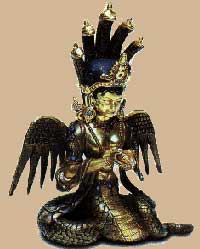 Differing sects regard Ananta as either a male cobra (naga) or female cobra (nagini), but whenever the cobra is the ultimate reality or cosmic energy or sea of bliss, she is always female.
Differing sects regard Ananta as either a male cobra (naga) or female cobra (nagini), but whenever the cobra is the ultimate reality or cosmic energy or sea of bliss, she is always female.The Naga Kanya or Cobra Women are typically viewed as a race of fairy-like demi-goddesses born of Vishnu's vehicle, & they may have the forms of beautiful maidens, but are usually maidens only from the waist up, serpents from the waist down.
A statue shown on this page depicts just such a Naga Kanya, half woman, half cobra. With her winged shoulders, & her cobra-hood headdress, there is an uncanny parrallel to this very Himalayan Cobra Lily with its immature leaves like Naga Kanya's wings, & its long stem mottled like that of a serpent, beneath the hood-like spathe.
Such a Naga Kanya is a bringer of treasures (akin to Lakshmi) but not merely of material wealth. She brings the ultimate treasure, wisdom, represented by the gem or diamond-pattern on the back of a cobra's hood or the jewel imbedded in Kanya's forhead.
Sometimes an undulating Naga & Nagini are depicted together. They are united in the divine sleep of Vishnu, & in the divine awakening (or getting of wisdom).
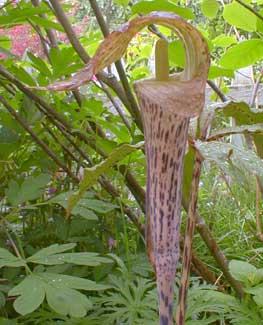 Ananta as ultimate energy is the sakta (energy-goddess) who holds the heavenly bodies in their places. When modern worshippers observe the heavens through telescopes, they are unsurprised that galaxies are coiled like Ananta, for science is never at odds with religion.
Ananta as ultimate energy is the sakta (energy-goddess) who holds the heavenly bodies in their places. When modern worshippers observe the heavens through telescopes, they are unsurprised that galaxies are coiled like Ananta, for science is never at odds with religion.By the name Kundalini this energizing goddess takes the form of a serpent coiled within each human being, for she is to each of us our individual spark of life. Without Her, we would not be sentient nor capable of movement.
The cobra is also understood to be a manifestation of Kali the Destroyer, though one must understand that Kali is a loving mother, a banisher of darkness & not merely the monstrous blood-drinker She may superficially appear to be. In a Buddhist context, it is the cobra that severes the soul from the painful cycle of rebirth to achieve the pure bliss.
All this & more which the serpent symbolizes is conferred also to the cobra lily, cultivated for its sacred meaning in temple gardens of the Himalayas. The flowers are typical shrine offerings in places like the Badrinath Vishnu Temple. Those which have flowers underneath the leaves are considered especially sacred because the flower itself becomes the divinity, with the overhanging leaves the equivalent of a sheltering cobra hood.
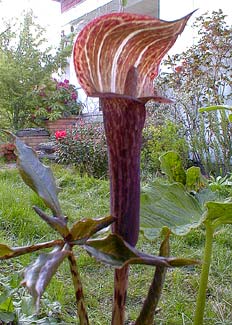 The genus name means "with kinship to arum" or "bloody dawn," & the species name means "resembling (carniverous) pitcher-plants" or "resembling the banisher of sorrow." This name is obviously rife with mythologicial import, but does not intentionally allude to the Naga as the banisher of sorrows, but to the cup which holds the magic brew, Nepenthes, which drugged the senses & induced a hallucinatory state of bliss. It is a fascinating "coincidence" that Nepenthes of mediterranean mythology has much the same meaning as the Indic cobras of divine slumber & divine awakening.
The genus name means "with kinship to arum" or "bloody dawn," & the species name means "resembling (carniverous) pitcher-plants" or "resembling the banisher of sorrow." This name is obviously rife with mythologicial import, but does not intentionally allude to the Naga as the banisher of sorrows, but to the cup which holds the magic brew, Nepenthes, which drugged the senses & induced a hallucinatory state of bliss. It is a fascinating "coincidence" that Nepenthes of mediterranean mythology has much the same meaning as the Indic cobras of divine slumber & divine awakening.The mouth of the spathe of A. nepenthoides is very open for an inside view & to assess the sex of the flower. A plant as a whole us not of two specific sexes, but the flower of each plant will be randomly one sex or the other depending on its age & growing conditions. A successfully pollinated female inflorescence produces a cob of berries or seeds during the summer.
The spathe is striped pink & green & brown, occuring in April & May. It has an odor reminiscent of swamp-water, suggesting to me that it wants to be pollinated by swamp flies.
Its native range is from Nepal to southeast China, in wet forested areas of the Himalayas. Because it ranges into alpine heights, it is very cold-hardy, & easily grown in any temperate or alpine shade garden.
The foliage follows after the spathe. Leaves are at first all folded against the back of the stem, making the stem & spathe look like it has sets of six slender wings, giving the impression of a flying cobra standing upright, perhaps in the manner of the Serpent before it tempted Eve, before it was forced to go henceforth upon its belly.
Over time, A. nepenthoides will spread into a clump by means of tuberous roots & offsets. It takes a few years for it to spread. When there are multiple flowers in the clump, one can wait for autumn dormancy to dig it up & remove offsets from the main flattish tuber to plant elsewhere. They can also be grown from their own seeds. Seedlings won't produce flowers for three to seven years.
Double-Whip Cobra Lily,
Arisaema speciosum